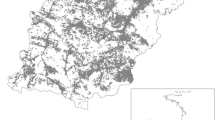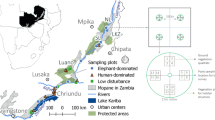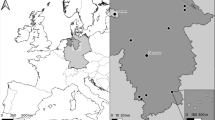Abstract
Agriculture and pastureland for cattle grazing are common land uses in Mediterranean landscapes. These activities significantly alter the habitat conditions, affecting the body conditions of wild communities, especially those with low vagility, such as small mammals. We aimed to evaluate how cattle grazing and the habitat composition affected the body condition of the wood mouse Apodemus sylvaticus in a southern Mediterranean agroforestry system using the Scale Mass Index (SMI) as an indicator of individuals condition. To assess variation in body condition, wood mice were live-trapped in a gradient of grazed sites with different stocking intensities, as well in sites excluded to grazing at different time periods (1998, 2004, and 2008). Wood mice body conditions were influenced by both microhabitat and macrohabitat drivers, with sex-biased patterns, while for the females, only the shrub species had an influence (a microhabitat variable); for the males, both the shrub species and the undercover density (and specifically their interaction) were the important drivers (microhabitat and macrohabitat variables). Unexpectedly, the physical condition variation detected between periods was not directly proportional to the exclusion period, but rather, a certain degree of similarity was found between the different sites (sites excluded since 2004 paired with grazed sites). These results suggest that the presence of food and shelter are determinants to the wood mouse’s physical condition: for females, securing food sources enhance the body condition, while for males, the degree of cover, and consequently refuge against predators, seems to be determinant. These results reinforce the need for sustainable landscape management to assure the maintenance of habitat heterogeneity.
Similar content being viewed by others
References
Alain B, Gilles P, Yannick D (2006) Factors driving small rodents assemblages from field boundaries in agricultural landscapes of western France. Landsc Ecol 21:449–461. https://doi.org/10.1007/s10980-005-4118-6
Alcántara M (1991) Geographical variation in body size of the wood mouse Apodemus sylvaticus L. Mammal Rev 21(3):143–150. https://doi.org/10.1111/j.1365-2907.1991.tb00115.x
Arnold TW (2010) Uninformative parameters and model selection using Akaike’s Information Criterion. J Wildl Manag 74:1175–1178. https://doi.org/10.2193/2009-367
Ascensão F, Clevenger AP, Grilo C, Filipe J, Santos-Reis M (2012) Highway verges as habitat providers for small mammals in agrosilvopastoral environments. Biodivers Conserv 21:3681–3697. https://doi.org/10.1007/s10531-012-0390-3
Auman HJ, Meathrel CE, Richardson A (2008) Supersize me: does anthropogenic food change the body condition of silver gulls? A comparison between urbanized and remote, non-urbanized area. Waterbirds 31(1):122–126. https://doi.org/10.1675/1524-4695
Bandeira V, Virgós E, Azevedo A, Carvalho J, Cunha M, Fonseca C (2019) Sex and season explain spleen weight variation in the Egyptian mongoose. Curr Zool 65:11–20. https://doi.org/10.1093/cz/zoy031
Barton K (2018) MuMIn: Multi-Model Inference. R package version 1.40.4. https://CRAN.R-project.org/package=MuMIn
Bates D, Maechler M, Bolker B, Walker S (2015) Fitting linear mixed-effects models using lme4. J Stat Softw 67:1–48. https://doi.org/10.18637/jss.v067.i01
Bellows AS, Pagels JF, Mitchell JC (2001) Macrohabitat and microhabitat affinities of small mammals in a fragmented landscape on the upper coastal plain of Virginia. Am Midl Nat 146:345–360. https://doi.org/10.1674/0003-0031
Bergallo HG, Magnusson WE (1999) Effects of climate and food availability on four rodent species in southeastern Brazil. J Mammal 80:472–486. https://doi.org/10.2307/1383294
Blondel J (2006) The “design” of Mediterranean landscapes: a millennial story of humans and ecological systems during the historic period. Hum Ecol 34:713–729. https://doi.org/10.1007/s10745-006-9030-4
Boitani L, Loy A, Molinari P (1985) Temporal and spatial displacement of two sympatric rodents (Apodemus sylvaticus and Mus musculus) in a Mediterranean coastal habitat. Oikos 45:246–252. https://doi.org/10.2307/3565711
Bolker B, Brooks M, Clark C, Geange S, Poulsen J, Stevens M, White J (2009) Generalized linear mixed models: a practical guide for ecology and evolution. Trends Ecol Evol 24:127–135. https://doi.org/10.1016/j.tree.2008.10.008
Bonecker ST, Portugal LG, Costa-Neto SF, Gentile R (2009) A long term study of small mammal populations in a Brazilian agricultural landscape. Mamm Biol 74:467–477. https://doi.org/10.1016/j.mambio.2009.05.010
Bourbonnais ML, Nelson TA, Cattet MR, Darimont CT, Stenhouse GB, Janz DM (2014) Environmental factors and habitat use influence body condition of individuals in a species at risk, the grizzly bear. Conserv Physiol 2(1):cou043. https://doi.org/10.1093/conphys/cou043
Bueno C, Ruckstuhl KE, Arrigo N, Aivaz AN, Neuhaus P (2012) Impacts of cattle grazing on small-rodent communities: an experimental case study. Can J Zool 90(1):22–30. https://doi.org/10.1139/z11-108
Burnham K, Anderson D (2002) Model selection and multimodel inference: a practical information-theoretic approach. Springer-Verlag, New York
Butet A (1985) Méthode d’étude du régime alimentaire d’un rongeur polyphage (Apodemus sylvaticus L., 1758) par l’analyse microscopique des fèces. Mammalia 49:455–483
Cameron RD, Smith WT, Fancy SG, Gerhart KL, White RG (1993) Calving success of female caribou in relation to body weight. Can J Zool 71:480–486. https://doi.org/10.1139/z93-069
Clements DR, Peterson DJ, Prasad R (2001) The biology of Canadian weeds. 112. Ulex europaeus L. Can J Plant Sci 81:325–337. https://doi.org/10.4141/P99-128
Corbalán V (2006) Microhabitat selection by murid rodents in the Monte Desert of Argentina. J Arid Environ 65:102–110. https://doi.org/10.1016/j.jaridenv.2005.07.006
Degen AA, Khokhlova IS, Kam M, Snider I (2002) Energy requirements during reproduction in female common spiny mice (Acomys Cahirinus). J Mammal 83(3):645–651. https://doi.org/10.1644/1545-1542
Eccard JA, Walther RB, Milton SJ (2000) How livestock grazing affects vegetation structures and small mammal distribution in the semi-arid Karoo. J Arid Environ 46:103–106. https://doi.org/10.1006/jare.2000.0659
Fernandes J, Petrucci-Fonseca F, Santos-Reis M, Rosalino LM (2019) Drivers of Psammodromus algirus abundance in a Mediterranean agroforestry landscape. Agrofor Syst 93:2281–2291. https://doi.org/10.1007/s10457-019-00348-w
Gittleman JL, Thompson SD (1998) Energy allocation in mammalian reproduction. Am Zool 28:863–875. https://doi.org/10.1093/icb/28.3.863
Gonçalves P, Alcobia S, Simões L, Santos-Reis M (2011) Effects of management options on mammal richness in a Mediterranean agro-silvo-pastoral system. Agrofor Syst 85:383–395. https://doi.org/10.1007/s10457-011-9439-7
Guinet C, Roux JP, Bonnet M, Mison V (1998) Effect of body size, body mass, and body condition on reproduction of female South African fur seals (Arctocephalus pusillus) in Namibia. Can J Zool 76:1418–1424. https://doi.org/10.1139/z98-082
Gurnell J, Flowerdew JR (2006) Live trapping small mammals: a practical guide. Mammal Society, London
Hartel T, von Wehrden H (2013) Farmed areas predict the distribution of amphibian ponds in a traditional rural landscape. PLoS One 8(5):e63649. https://doi.org/10.1371/journal.pone.0063649
Holter P (1983) Effect of earthworms on the disappearance rate of cattle droppings. In: Satchell JE (ed) Earthworm ecology. Chapman and Hall Ltd, London, pp 49–57
Jedrzejewska B, Jedrzejewski W (1990) Antipredatory behaviour of bank voles and prey choice of weasels - enclosure experiments. Acta Zool Fenn 27:321–328
Jorgensen EE (2004) Small mammal use of microhabitat reviewed. J Mammal 85:531–539. https://doi.org/10.1644/BER-019
Khidas H, Khammes N, Khelloufi S, Lek S, Aulagnier S (2002) Abundance of the wood mouse Apodemus sylvaticus and the Algerian mouse Mus spretus (Rodentia, Muridae) in different habitats of northern Algeria. Mamm Biol 67:34–41. https://doi.org/10.1078/1616-5047-00003
Liker A, Papp Z, Bókony V, Lendvai ÁZ (2008) Lean birds in the city: body size and condition of house sparrows along the urbanization gradient. J Anim Ecol 77:789–795. https://doi.org/10.1111/j.1365-2656.2008.01402.x
Lima M, Stenseth NC, Jaksic FM (2002) Food web structure and climate effects on the dynamics of small mammals and owls in semi-arid Chile. Ecol Lett 5:273–284. https://doi.org/10.1046/j.1461-0248.2002.00312.x
Longland WS, Jenkins SH (1987) Sex and age affect vulnerability of desert rodents to owl predation. J Mammal 68:746–754. https://doi.org/10.2307/1381551
Longland WS, Price MV (1991) Direct observations of owls and heteromyid rodents: can predation risk explain microhabitat use? Ecology 72(6):2261–2273. https://doi.org/10.2307/1941576
Lovegrove BG (2003) The influence of climate on the basal metabolic rate of small mammals: a slow-fast metabolic continuum. J Comp Physiol B 173:87–112. https://doi.org/10.1007/s00360-002-0309-5
Maceda-Veiga A, Green AJ, De Sostoa A (2014) Scaled body-mass index shows how habitat quality influences the condition of four fish taxa in north-eastern Spain and provides a novel indicator of ecosystem health. Freshw Biol 59:1145–1160. https://doi.org/10.1111/fwb.12336
Malo JE, Suarez F (1998) The dispersal of a dry-fruited shrub by red deer in a Mediterranean ecosystem. Ecography 21(2):204–211. https://doi.org/10.1111/j.1600-0587.1998.tb00673.x
Michel N, Burel F, Legendre P, Butet A (2007) Role of habitat and landscape in structuring small mammal assemblages in hedgerow networks of contrasted farming landscapes in Brittany, France. Landsc Ecol 22:1241–1253. https://doi.org/10.1007/s10980-007-9103-9
Milenkaya O, Catlin DH, Legge S, Walters JR (2015) Body condition indices predict reproductive success but not survival in a sedentary, tropical bird. PLoSONE 10(8):e0136582. https://doi.org/10.1371/journal.pone.0136582
Millar JS, Hickling GJ (1990) Fasting endurance and the evolution of mammalian body size. Funct Ecol 4:5–12. https://doi.org/10.2307/2389646
Møller AP, Christe P, Erritzøe J, Mavarez J (1998) Condition, disease and immune defence. Oikos 83:301–306
Morris DW (1984) Patterns and scale of habitat use in two temperate zone of small mammal faunas. Can J Zool 62:1540–1547. https://doi.org/10.1139/z84-225
Morris DW (1987) Ecological state and habitat use. Ecology 68:362–369. https://doi.org/10.2307/1939267
Murray DL (2002) Differential body condition and vulnerability to predation in snowshoe hares. J Anim Ecol 71:614–625. https://doi.org/10.1046/j.1365-2656.2002.00632.x
Nakazawa M (2018) fmsb: functions for medical statistics book with some demographic data. R package version 0.6.3. https://CRAN.R-project.org/package=fmsb. Accessed 26 June 2018
Nakagawa S, Schielzeth H (2013) A general and simple method for obtaining R2 from generalized linear mixed-effects models. Methods Ecol Evol 4(2):133–142. https://doi.org/10.1111/j.2041-210x.2012.00261.x
Orrock JL, Pagels JF, Mcshea WJ, Harper EK (2000) Predicting presence and abundance of a small mammal species: the effect of the scale and resolution. Ecol Appl 10:1356–1366. https://doi.org/10.1890/1051-0761
Peig J, Green AJ (2009) New perspectives for estimating body condition from mass/length data: the scaled mass index as an alternative method. Oikos 118:1883–1891. https://doi.org/10.1111/j.1600-0706.2009.17643.x
Peig J, Green AJ (2010) The paradigm of body condition: a critical reappraisal of current methods based on mass and length. Funct Ecol 24:1323–1332. https://doi.org/10.1111/j.1365-2435.2010.01751.x
Pocock MJ, Jennings N (2008) Testing biotic indicator taxa: the sensitivity of insectivorous mammals and their prey to the intensification of lowland agriculture. J Appl Ecol 45(1):151–160. https://doi.org/10.1111/j.1365-2664.2007.01361.x
Previtali MA, Lima M, Meserve PL, Kelt DA, Gutiérrez JR (2009) Population dynamics of two sympatric rodents in a variable environment; rainfall, resource availability, and predation. Ecology 90(7):1996–2006. https://doi.org/10.1890/08-0405.1
R Core Team (2015) R: a language and environment for statistical computing. R Foundation for Statistical Computing, Vienna. https://www.R-project.org/. Accessed 26 June 2018
Robbins CT, Ben-David M, Fortin JK, Nelson OL (2012) Maternal condition determines birth date and growth of newborn bear cubs. J Mammal 93:540–546. https://doi.org/10.1644/11-MAMM-A-155.1
Rosalino LM, Santos-Reis M (2009) Fruit consumption by carnivores in Mediterranean Europe. Mammal Rev 39(1):67–78. https://doi.org/10.1111/j.1365-2907.2008.00134.x
Rosalino LM, Rosa S, Santos-Reis M (2010) The role of carnivores as Mediterranean seed dispersers. Ann Zool Fenn 47(3):195–205. https://doi.org/10.5735/086.047.0304
Rosalino LM, Ferreira D, Leitão I, Santos-Reis M (2011a) Selection of nest sites by wood mice Apodemus sylvaticus in a Mediterranean agro-forest landscape. Ecol Res 26:445–452. https://doi.org/10.1007/s11284-010-0797-9
Rosalino LM, Ferreira D, Leitão I, Santos-Reis M (2011b) Usage patterns of Mediterranean agro-forest habitat componentes by wood mice Apodemus sylvaticus. Mamm Biol 76:268–273. https://doi.org/10.1016/j.mambio.2010.08.004
Rosário IT, Mathias ML (2004) Annual weight variation and reproductive cycle of the wood mouse (Apodemus sylvaticus) in a Mediterranean environment. Mammalia 68:133–140. https://doi.org/10.1515/mamm.2004.014
Santos JPV, Vicente J, Carvalho J, Queirós J, Villamuelas M, Albanell E, Acevedo P, Gortázar C, López-Olvera JR, Fonseca C (2018) Determining changes in the nutritional condition of red deer in Mediterranean ecosystems: effects of environmental, management and demographic factors. Ecol Indic 87:261–271. https://doi.org/10.1016/j.ecolind.2017.12.039
Sanz B (1997) Huellas e rastros de los mamíferos ibéricos (Mamíferos semiurbanos). Libros Certeza, Zaragoza
Tarjuelo R, Morales MB, Traba J (2011) Breadth and specialization in microhabitat selection: the case of the Algerian mouse (Mus spretus) in Central Spain. Revue d'Ecologie (Terre & Vie) 67:1–12
Tattersall FH, Macdonald DW, Hart BJ, Manley WJ, Feber RE (2001) Habitat use by wood mice (Apodemus sylvaticus) in a changeable arable landscape. J Zool 255:487–494. https://doi.org/10.1017/S095283690100156X
Teixeira D (2015) Riqueza, densidade e condição física de micromamíferos numa plantação de eucaliptos. MSc Dissertation, University of Lisbon, Lisbon
Teixeira D, Carrilho M, Mexia T, Köbel M, Santos MJ, Santos-Reis M, Rosalino LM (2017) Management of Eucalyptus plantations influences small mammal density: evidence from Southern Europe. For Ecol Manag 385:25–34. https://doi.org/10.1016/j.foreco.2016.11.009
Teixeira D, Carrilho M, Silva M, Nunes M, Vieira ML, Novo MT, Santos-Reis M, Rosalino LM (2019) Mediterranean Eucalyptus plantations affect small mammal ectoparasites abundance but not individual body condition. Ecol Res 34(3):415–427. https://doi.org/10.1111/1440-1703.12003
Tew TE, Macdonald DW (2000) Arable habitat use by wood mice (Apodemus sylvaticus). 2. Microhabitat. J Zool 250:305–311
Todd IA, Tew TE, Macdonald DW (2000) Arable habitat use by wood mice (Apodemus sylvaticus). 1. Macrohabitat. J Zool 250:299–303
Torre I, Díaz M (2004) Small mammal abundance in Mediterranean post-fire habitats: a role for predators? Acta Oecol 25:137–143. https://doi.org/10.1016/j.actao.2003.10.007
Torre I, Arrizabalaga A, Díaz M (2002) Ratón de campo (Apodemus sylvaticus Linnaeus, 1758). Galemys 14:1–26
Torre I, Díaz M, Martínez-Padilla J, Bonal R, Viñuela J, Fargallo JA (2007) Cattle grazing, raptor abundance and small mammal communities in Mediterranean grasslands. Basic Appl Ecol 8:565–575. https://doi.org/10.1016/j.baae.2006.09.016
Traba J, Acebes P, Campos V, Giannoni SM (2009) Habitat selection by two sympatric rodent species in the Monte desert, Argentina. First data for Eligmodontia moreni and Octomis mimax. J Arid Environ 74:179–185. https://doi.org/10.1016/j.jaridenv.2009.06.017
Vásquez RA, Ebensperger LA, Bozinovic F (2002) The influence of habitat on travel speed, intermittent locomotion, and vigilance in a diurnal rodent. Behav Ecol 13(2):182–187. https://doi.org/10.1093/beheco/13.2.182
Verdú JR, Moreno CE, Sánchez-Rojas G, Numa C, Galante E, Halffter G (2007) Grazing promotes dung beetle diversity in the xeric landscape of a biosphere reserve in Mexico. Biol Conserv 104:308–317. https://doi.org/10.1016/j.biocon.2007.08.015
Verrier D, Groscolas R, Guinet C, Arnould JPY (2011) Development of fasting abilities in subantarctic fur seal pups: balancing the demands of growth under extreme nutritional restrictions. Funct Ecol 25:704–717. https://doi.org/10.1111/j.1365-2435.2010.01823.x
Wei-chun M (1989) Effect of soil pollution with metallic lead pellets on lead bioaccumulation and organ/body weight alterations in small mammals. Arch Environ Contam Toxicol 18:617–622. https://doi.org/10.1007/BF01055030
Wilson CR, Voorhis V, Morgan BL (2007) Understanding power and rules of thumb for determining sample sizes. Tutor Quant Methods Psychol 3(2):43–50. https://doi.org/10.20982/tqmp.03.2.p043
Wolton RJ (1985) The ranging and nesting behaviour of wood mice, Apodemus sylvaticus (Rodentia: Muridae), as revealed by radio-tracking. J Zool 206:203–224. https://doi.org/10.1111/j.1469-7998.1985.tb05645.x
Yom-Tov Y, Geffen E (2006) Geographic variation in body size: the effects of ambient temperature and precipitation. Oecologia 148:213–218. https://doi.org/10.1007/s00442-006-0364-9
Zar JH (2010) Biostatistical analysis. Pearson Prentice Hall, Upper Saddle River
Zubaid A, Gorman ML (1991) The diet of wood mice Apodemus sylvaticus living in a sand dune habitat in north-east Scotland. J Zool 225(2):227–232. https://doi.org/10.1111/j.1469-7998.1991.tb03813.x
Zuur AF, Ieno EN, Smith GM (2007) Analysing ecological data. Springer, New York
Zuur AF, Ieno EN, Walker NJ, Saveliev AA, Smith GM (2009) Mixed effects models and extensions in ecology with R. Springer, New York
Acknowledgments
Thanks are due for the financial support to CESAM (UID/AMB/50017/2019), to FCT/MCTES through national funds, and the co-funding by the FEDER, within the PT2020 Partnership Agreement and Compete 2020. Furthermore, this work was also funded by national funds through FCT - Fundação para a Ciência e a Tecnologia in the frame of the project UID/BIA/00329/2019. We would like also to thank the Administration Board of Companhia das Lezírias S.A. and Eng. Rui Alves (Coordinator of the Forestry and Natural Resources Department) for providing logistical support crucial to develop our study.
Author information
Authors and Affiliations
Corresponding author
Additional information
Publisher’s note
Springer Nature remains neutral with regard to jurisdictional claims in published maps and institutional affiliations.
Rights and permissions
About this article
Cite this article
Fragoso, R., Santos-Reis, M. & Rosalino, L.M. Drivers of wood mouse body condition in Mediterranean agroforestry landscapes. Eur J Wildl Res 66, 13 (2020). https://doi.org/10.1007/s10344-019-1356-5
Received:
Revised:
Accepted:
Published:
DOI: https://doi.org/10.1007/s10344-019-1356-5




